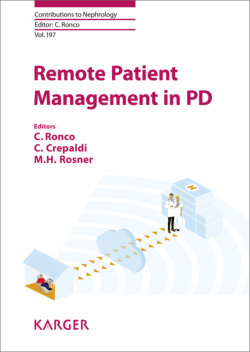Remote Patient Management in Peritoneal Dialysis

Реклама. ООО «ЛитРес», ИНН: 7719571260.
Оглавление
Группа авторов. Remote Patient Management in Peritoneal Dialysis
Contributions to Nephrology
Remote Patient Management in Peritoneal Dialysis
Contents
Preface
Historical Milestones in Peritoneal Dialysis
Abstract
The Peritoneal Membrane/Cavity as a Therapeutic Tool
PD Solutions
PD Technique Evolution
The Birth of Continuous Ambulatory PD
Introduction of Y Set in PD
PD Dose
Unplanned and Urgent Start PD
References
Evolution of Automated Peritoneal Dialysis Machines
Abstract
Introduction
Origin of APD
Evolution of Cyclers
HOMECHOICE CLARIA/SHARESOURCE Revolution
Conclusion and Future Perspectives
References
Two-Way Patient Monitoring in PD: Technical Description of Sharesource
Abstract
Overview
Need for Sharesource
Indications for Use [1–3]
Sharesource Concepts. Treatment Files
Device Settings
Sharesource User Roles
Critical Design Elements
Sharesource Features
Remote Connectivity and Device Communication
SHARESOURCE Clinical Portal
Sharesource Workflow
References
Practical Aspects on Use of Sharesource in Remote Patient Management
Abstract
Acknowledgments
Disclosure Statement
References
Remote Patient Management: Balancing Patient Privacy, Data Security, and Clinical Needs
Abstract
Introduction
Ethical Considerations in Remote Monitoring
Data Privacy and Confidentiality
Principles of Data Security
Data Encryption
Data Authentication
The Patient’s Perspective
Ownership of Health Data
Concluding Considerations
References
Remote Patient Management in Peritoneal Dialysis: Impact on Clinician’s Practice and Behavior
Abstract
Introduction
Telemedicine and Remote Monitoring
SHARESOURCE® Platform
RM in APD: Adherence to Dialysis Prescription
RM in APD: APD UF
RM in APD: Clinical Management of Alarms
Treatment Time
Treatment Modifications
Patient Intervention
System Errors
Disclosure Statement
References
Remote Patient Management in Peritoneal Dialysis: Opportunities and Challenges
Abstract
Background
Opportunities and Challenges
Implementing Remote Monitoring of PD
Patient Independence and Increased PD Uptake
Reducing Technique Failure
Review of Biometric Data
Hospital and Home Visits
Patient Satisfaction and Adherence to Therapy
Data Safety and Reliability
Conclusion
References
Managing Peritoneal Dialysis Complications through Remote Patient Management Protocols
Abstract
RM and PD Adequacy
RM and UF
Long-Term Variation in UF
Short- and Mid-Term Changes in UF
References
Use of Sharesource in Remote Patient Management in Peritoneal Dialysis: A UK Nurse’s Perspective
Abstract
Background
How to Implement RPM/Sharesource onto a PD Unit?
Who Will Be Responsible for Monitoring the RPM?
Which Patients Should Have RPM?
Which Safety Settings (“Flag Rules” and “Priority Values”) Should Be Set?
How Frequently Will Sharesource Be Monitored?
Patient Education
RPM: Impact on Nursing Practice and How It Can Be Used to Improve Patient Outcomes
Individualized PD Prescriptions/Optimizing Patient Drains
Constipation Management
Clinic Appointments and Hospitalizations
The Future of RPM
Summary
References
Use of Sharesource in Remote Patient Management in Peritoneal Dialysis: A Canadian Nurse’s Perspective
Abstract
Background
Case Study 1: Blind Patient Trained on the AMIA with Sharesource (December 2017)
Sharesource after 6 Months
Sharesource after 1 Year
Case Study 2
Case Study 3
Case Study 4
Conclusion
References
Remote Patient Management in Peritoneal Dialysis: An Answer to an Unmet Clinical Need
Abstract
Introduction
Rationale for RPM
Features of a RPM System for PD. 1. Augmented Communication between Patients and Healthcare Delivery Systems Resulting in Efficient and Sustainable Self-Care
2. User-Generated Clinical Data and Non-Invasive Monitoring of Clinical Parameters through Wearable Sensors and IoT Devices Resulting in Real-Time Clinical Documentation
3. Automated Clinical Decision Support System (CDSS)-Driven System That Will Respond Immediately to Patient Input and Provide Advice Consistent with Guidelines on the Management of Their Condition
4. Patient Education and Support System
5. Electronic Prescription Management Facilitating Personalized Therapy in Real-Time
6. Virtual Presence or Copresence by Which a Sense of Connection with Another in a Mediated or Online Environment Is Real, Immediate, or Present
Specific Features for RPM in PD. Self-Monitoring Applications
Communication System
Alerts
Clinical Decision Support System
Measuring Care Quality and Tracking Outcomes
Technology Framework for RPM in PD
Overarching System for a Hybrid Care Delivery in PD
Looking Ahead: RPM in the Age of Machine Learning and Artificial Intelligence
References
Can Remote Patient Management Improve Outcomes in Peritoneal Dialysis?
Abstract
Introduction
Can RPM Improve PD Utilization?
RPM in PD: How Are We Monitoring? What Are We Monitoring?
PD Access Dysfunction
Treatment Adherence
Hospitalization and Emergency Department Visit Reduction
PD-Related Infections
Patient-Reported Outcomes
RPM: Lessons Learnt from Home Hemodialysis
Future Evaluation of RPM
Disclosure Statement
References
Remote Patient Management in Peritoneal Dialysis Improves Clinical Outcomes
Abstract
Introduction
Home-Based Healthcare for Patients with End-Stage Renal Disease
Benefits of Remote Monitoring for PD Patients
Short-Term Outcomes
Prescription Modification
Hospital Consults
Long-Term Outcomes
Prescription Changes
Hospital Consults
Care Team (Physician and Nurse) Time
Patient Time and Expenses
Problem Resolution and Treatment Troubleshooting
Nocturnal Alarms
Patient Compliance to Treatment Prescription
Patient Drop-Out from PD and Technique Survival
Unscheduled Hospital Visits
Hospitalization
Other Outcome Parameters
General Remarks
Conclusion
Disclosure Statement
References
Health Economic Implications of Remote Patient Management
Abstract
Introduction
Overview of RPM and Telehealth
Outcome Data for RPM/Telehealth Programs
Can RPM/Telehealth Increase the Uptake of Peritoneal Dialysis?
Can RPM/Telehealth Lead to Better Outcomes and Lower Costs for PD Patients?
Reduction in Hospital Readmission Rates with RPM and Telehealth
Case Example
Summary
References
Remote Patient Management for Emerging Geographical Areas
Abstract
Prevalence and Outcomes of Remote ESRD Patients
PD in Remote ESRD Patients and Challenges for the Management
Strategy of Managing Remote ESRD PD Patients
PD Satellite Center Model for the Management of Remote PD Patients
Comprehensive Follow-Up Program for the Management of Remote PD Patients
Disclosure Statement
Acknowledgements
References
Remote Patient Management in Home Dialysis: Planning Considerations for the Future
Abstract
Introduction
Starting a RPM Program. What Should Be Monitored?
How Often and How Long Should Patients Be Monitored?
Who Should Be Monitored?
How to Monitor?
Why Monitor? Benefits of RPM
Barriers to Implementation of RPM
Possible Solutions to RPM Barriers
Conclusion
References
Remote Patient Management: The Future Is G.R.E.E.N
Abstract
Introduction
The Future of RPM in PD
Genetics
Robotics
E-Health and Information/Communication Systems
Eco-Compatibility
Nanosciences
Conclusions
References
Author Index
Subject Index
Отрывок из книги
Vol. 197
Series Editor
.....
Use of Sharesource in Remote Patient Management in Peritoneal Dialysis: A UK Nurse’s Perspective
Blaauw, M. (London)
.....